2007 KIA CARNIVAL reset
[x] Cancel search: resetPage 1260 of 1575

4.Operation control
a. Prioritization of operations
Motor starting is delayed for 100ms respectively in case of auto control to prevent rush current from overlap
when motors are running, and it follows the following order.
Slide > recline > front height > rear height > adjust pedal
b. Memory preset recall is conducted in the following order, and delay time for each motor is as follows.
T1 : Manimum 0.1 sec.
Continuous cooperation TIMER value for each motor
Slide: 15 sec., recline: 30 sec., front height: 5 sec., rear height: 8 sec., adjust pedal: 10 sec.
c. Control when turning to the opposite direction
When motor has to be run in a reverse direction during Easy access function or preset recall operation, stop the
operation immediately, wait for 100ms and then try operation to the reverse direction.
d. If the difference between position and the current one is below specified value, motor will not run even though
preset recall data is received.
Slide, recline, front height, rear height : 6PULSE
Adjust pedal: 3LSB(about 0.06V)
e. Operation will stop upon reaching Motor's target point when conducting Easy access function or preset recall
operation.
EASY ACCESS FUNCTION OPERATION (SLIDE MOTOR ONLY)
1.Easy access function operation is allowed only when auto switch is on, and the operation will be halted if auto
switch changes from on to off.
2. If a key is removed and CAN BUS data transmitted from IPM changes from "on" to "off", the seat slide will move
50mm backward based on the IGN off point. If a key off position is farther back than 50mm against the IGN off
point, get - off gearing will not be conducted. If slide rear limit becomes off in the middle of backward operation,
retreat control will be halted.
3. The following conditions will be identified and processed by IMS, and if any one of the following conditions is met,
Easy access function operation will be prevented or halted.
a. When "P" position switch is not on.
b. When Vehicle Speed in CAN BUS data transmitted from cluster is "3km/h" or faster.
c. When seat and pedal is under manual switch operation.
d. When auto switch is off.
4. When control is halted in the middle of backward operation, the remaining operation will not be completed, and
when returning, it will return just as much as it retreated.
5. It will move to IGN off point in case of Get- on gearing by key in despite manual switch input during or after
backward operation.
6. After the key is removed, on the condition of SLEEP state, Easy access function operation will be conducted after
150ms if the key is inserted when auto switch is turned ON(OFF) from Off(ON).
Page 1261 of 1575

MEMORY STORAGE OPERATION BY KEYLESS
1.If "ID1" or "ID2" is received during keyless lock operation, record seat and pedal position in keyless code. (there is
no buzzer output during memory storage operation by keyless)
2. Memory storage operation is allowed for a single ID after a change of IG from "on" →"off".
3. Any one of the following conditions will prevent keyless Memory storage operation.
a. When "P" position switch is not on.
b. When Vehicle Speed in CAN BUS data transmitted from CLUSTER is "3km/h" or faster.
c. When seat and pedal is manipulated by CAN BUS and manual switch.
d. When IG transmitted from IPM is other than off.
PRESET RECALL OPERATION BY KEYLESS
1.When IG is off (CAN BUS data IG transmitted from IPM is "off") and a key is removed (CAN BUS data Key
Reminder Switch transmitted from IPM is "off"), and if "ID1" or "ID2" is received during keyless unlock operation, it
automatically adjusts seat and pedal positions as memorized in keyless code (there is no buzzer output during
preset recall operation by keyless). However, seat slide adjustment position is determined as follows, depending on
Auto switch.
a. When auto switch is on ("IMS Auto Switch" is "on") , the position is automatically adjusted to 50 mm farther
back than target position, and if a key is inserted ("Key Reminder Switch" changes from "off" to "on"), it
conducts Get- on gearing operation to a target preset recall position.
b. If auto switch is off ("IMS Auto Switch" is "off"), it moves to the target memory play position.
2. Any one of the following conditions will prevent preset recall operation.
a. When "P" position switch is not on.
b. When Vehicle Speed in CAN BUS data transmitted from cluster is "3km/h" or faster.
c. When seat and pedal is manipulated by CAN BUS and manual switch.
d. When IG Switch transmitted from IPM is other than off.
e. When a key is inserted.
3. Playing will be halted during preset recall operation if any of the following conditions is met.
a. When "P" position switch is not on.
b. When vehicle speed in CAN BUS data transmitted from cluster is "3km/h" or faster.
c. When seat and pedal is manipulated by CAN BUS and manual switch.
SETTING LIMIT
1.A limit switch is installed to prevent the seat from traveling beyond the maximum forward/reward positions.
2. No limit switch is installed for the recline, height, or pedal adjustments. Arbitrary limit positions are used for these
functions.
DETECTING ERRORS FOR SEAT
Take countermeasure against error if the following conditions occur during manual switch operation.
a. Error when pulse is not fed.
SlideReclineFront height Rear height
Page 1326 of 1575
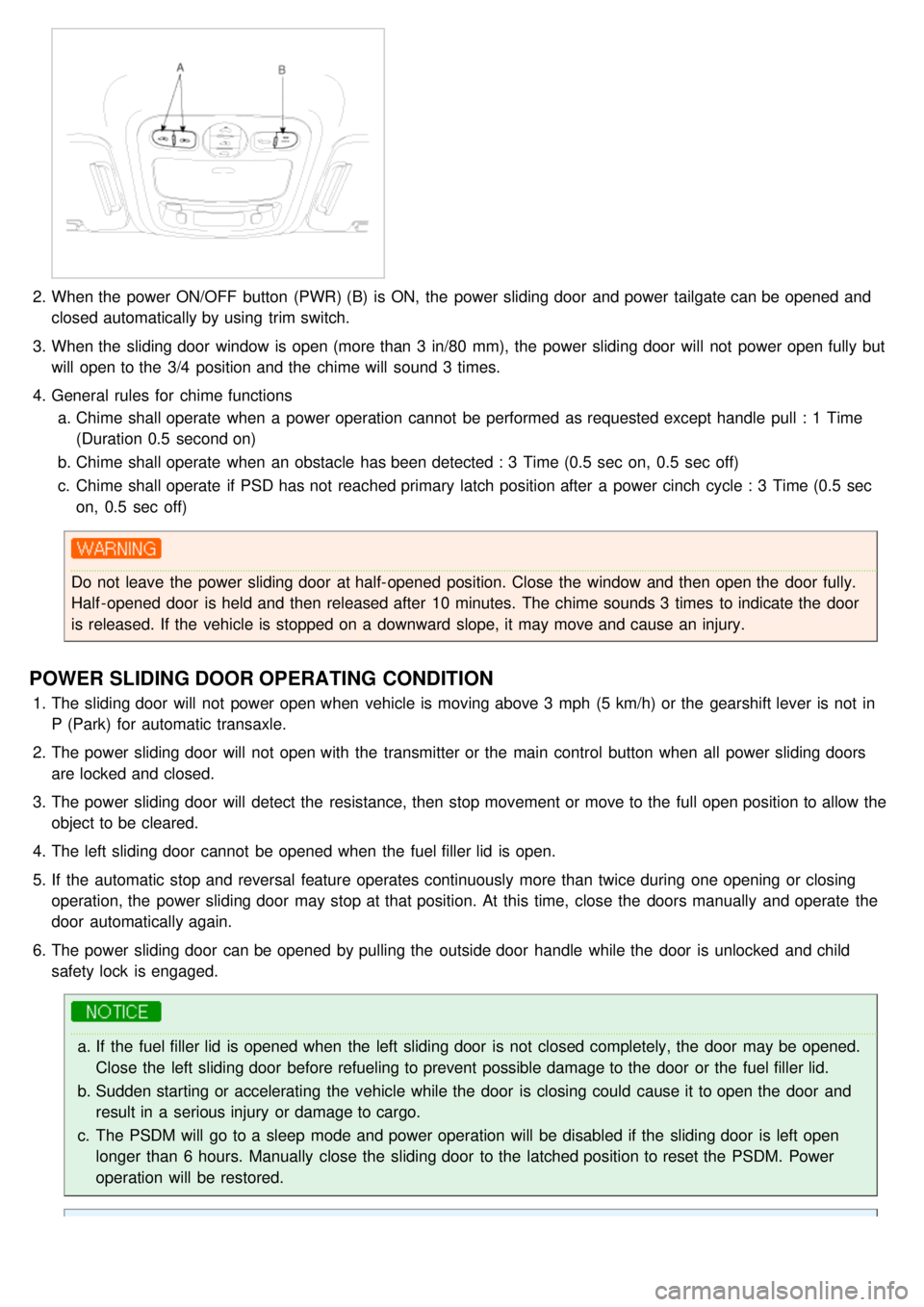
2.When the power ON/OFF button (PWR) (B) is ON, the power sliding door and power tailgate can be opened and
closed automatically by using trim switch.
3. When the sliding door window is open (more than 3 in/80 mm), the power sliding door will not power open fully but
will open to the 3/4 position and the chime will sound 3 times.
4. General rules for chime functions
a. Chime shall operate when a power operation cannot be performed as requested except handle pull : 1 Time
(Duration 0.5 second on)
b. Chime shall operate when an obstacle has been detected : 3 Time (0.5 sec on, 0.5 sec off)
c. Chime shall operate if PSD has not reached primary latch position after a power cinch cycle : 3 Time (0.5 sec
on, 0.5 sec off)
Do not leave the power sliding door at half- opened position. Close the window and then open the door fully.
Half - opened door is held and then released after 10 minutes. The chime sounds 3 times to indicate the door
is released. If the vehicle is stopped on a downward slope, it may move and cause an injury.
POWER SLIDING DOOR OPERATING CONDITION
1.The sliding door will not power open when vehicle is moving above 3 mph (5 km/h) or the gearshift lever is not in
P (Park) for automatic transaxle.
2. The power sliding door will not open with the transmitter or the main control button when all power sliding doors
are locked and closed.
3. The power sliding door will detect the resistance, then stop movement or move to the full open position to allow the
object to be cleared.
4. The left sliding door cannot be opened when the fuel filler lid is open.
5. If the automatic stop and reversal feature operates continuously more than twice during one opening or closing
operation, the power sliding door may stop at that position. At this time, close the doors manually and operate the
door automatically again.
6. The power sliding door can be opened by pulling the outside door handle while the door is unlocked and child
safety lock is engaged.
a.If the fuel filler lid is opened when the left sliding door is not closed completely, the door may be opened.
Close the left sliding door before refueling to prevent possible damage to the door or the fuel filler lid.
b. Sudden starting or accelerating the vehicle while the door is closing could cause it to open the door and
result in a serious injury or damage to cargo.
c. The PSDM will go to a sleep mode and power operation will be disabled if the sliding door is left open
longer than 6 hours. Manually close the sliding door to the latched position to reset the PSDM. Power
operation will be restored.
Page 1331 of 1575

2007 > 2.7L V6 GASOLINE >
TROUBLESHOOTING
Check the following items prior to performing Power Sliding Door System service.
1. Manual movement
Make sure the sliding door moves manually. Place the ON/OFF switch on the overhead console in the OFF
position. Move the door manually and check for proper door fit and latch effort. Check for interference with other
body parts such as latch striker, trim, and weather seals.
2. Battery voltage
Make sure the battery is fully charged. The PSD system is an electronic device and requires a minimum battery
voltage to operate. The PSDM(Power sliding door module) monitors the battery voltage present at the PSDM input
battery input and will not permit operation if the battery voltage is out of range.
3. Fuses
Two fuses protect the battery supply to the PSDM(Power sliding door module), one for Power, and one for logic.
Check that the fuses are intact
4. Repeat Operations
Make sure the customer has not been operating the PSD repeatedly while the vehicle is turned off. The battery will
be discharged and the PSDM(Power sliding door module) will not permit operation.
5. Vehicle on Steep Grade
Make sure the customer has not been operating the PSD system when the vehicle is parked on a steep grade
(greater than 30%). The system will operate but the force of gravity and normal flex of the vehicle body may affect
proper operation.
6. Obstacle Detection
The obstacle detection force is not adjustable. Factors that may affect the force are vehicle grade, battery voltage,
or dirt in sliding door tracks.
7. Outside handle response time
When the vehicle has been parked and OFF, there may be a delay before power operation starts after the outside
handle is pulled. This is normal because the PSDM(Power sliding door module) must wake up and check for proper
conditions before starting a power open operation.
8. The sliding doors are not identical. Open and close times and obstacle detection efforts may vary when comparing
the two doors. This is normal and is caused by vehicle build conditions such as door fit and rolling resistance.
9. Scan tool Diagnostic tool
Connect Scan tool to the K- line and check status of system.
POWER SLIDING DOOR SYSTEM DIAGNOSIS
CONDITION POSSIBLE CAUSES CORRECTION
Sliding Door opens
unexpectedly Accidental activation or failure of
open/close command switch
Check for shorted or defective switch
Failure of latch assembly Check wiring connections
Check for diagnostic trouble codes
Failure of Power Sliding Door or Body
Control module Disconnect then reconnect battery or fuse to
reset module and function sliding door. If no
function exists check for loose wire
connections. See Body Diagnostic Manual for
detailed procedures
Sliding Door will not power
open or close Not in Park or false indication
Check switch status with SCAN tool
Battery voltage at PSDM is too low
<9.5V to start operation and
<8.0V to continue operation Check for proper voltage at the PSDM.
Charge battery
Blown fuse Check for blown fuse
BCM or sliding door control module
Page 1336 of 1575
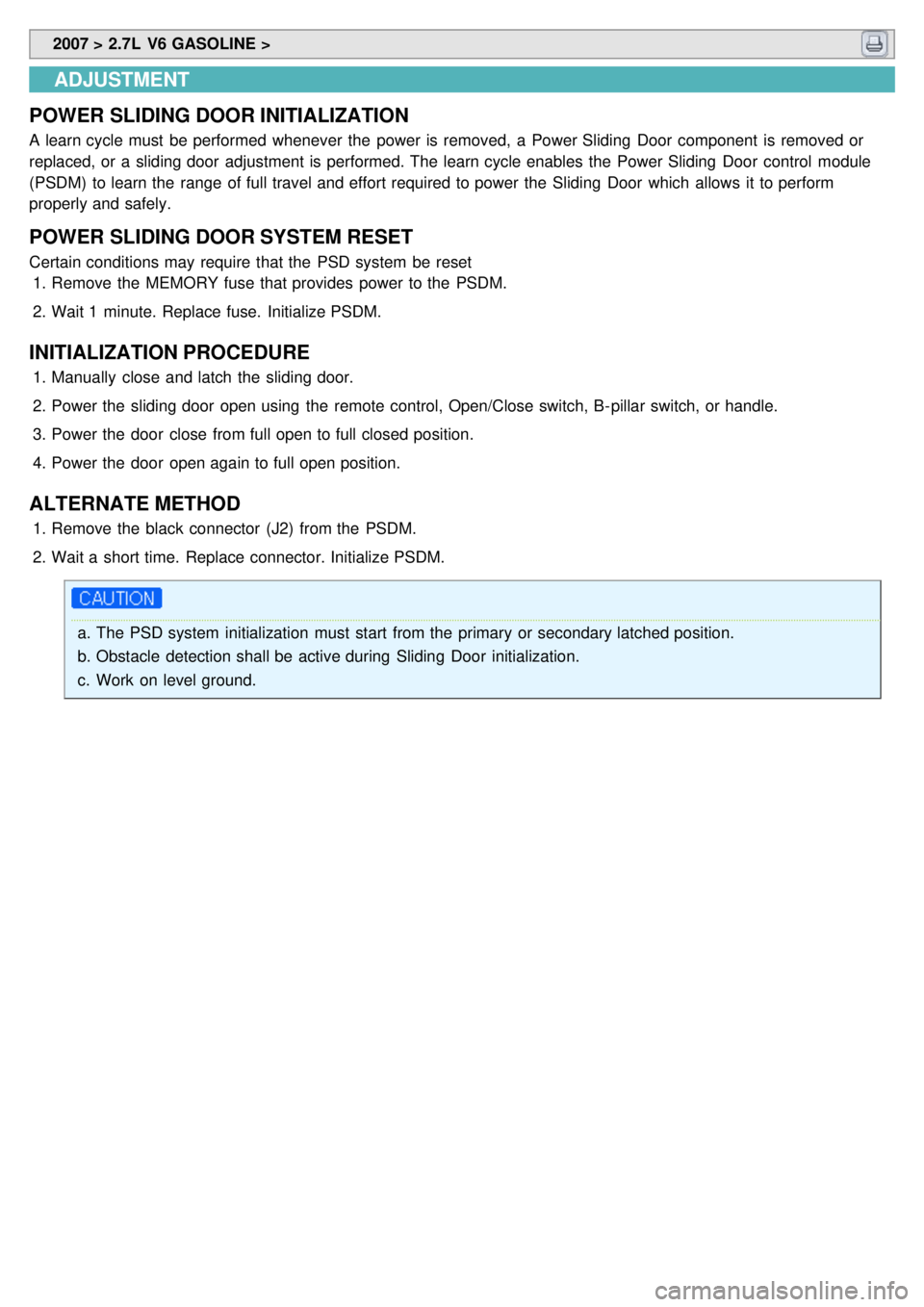
2007 > 2.7L V6 GASOLINE >
ADJUSTMENT
POWER SLIDING DOOR INITIALIZATION
A learn cycle must be performed whenever the power is removed, a Power Sliding Door component is removed or
replaced, or a sliding door adjustment is performed. The learn cycle enables the Power Sliding Door control module
(PSDM) to learn the range of full travel and effort required to power the Sliding Door which allows it to perform
properly and safely.
POWER SLIDING DOOR SYSTEM RESET
Certain conditions may require that the PSD system be reset 1. Remove the MEMORY fuse that provides power to the PSDM.
2. Wait 1 minute. Replace fuse. Initialize PSDM.
INITIALIZATION PROCEDURE
1.Manually close and latch the sliding door.
2. Power the sliding door open using the remote control, Open/Close switch, B- pillar switch, or handle.
3. Power the door close from full open to full closed position.
4. Power the door open again to full open position.
ALTERNATE METHOD
1.Remove the black connector (J2) from the PSDM.
2. Wait a short time. Replace connector. Initialize PSDM.
a.The PSD system initialization must start from the primary or secondary latched position.
b. Obstacle detection shall be active during Sliding Door initialization.
c. Work on level ground.
Page 1369 of 1575
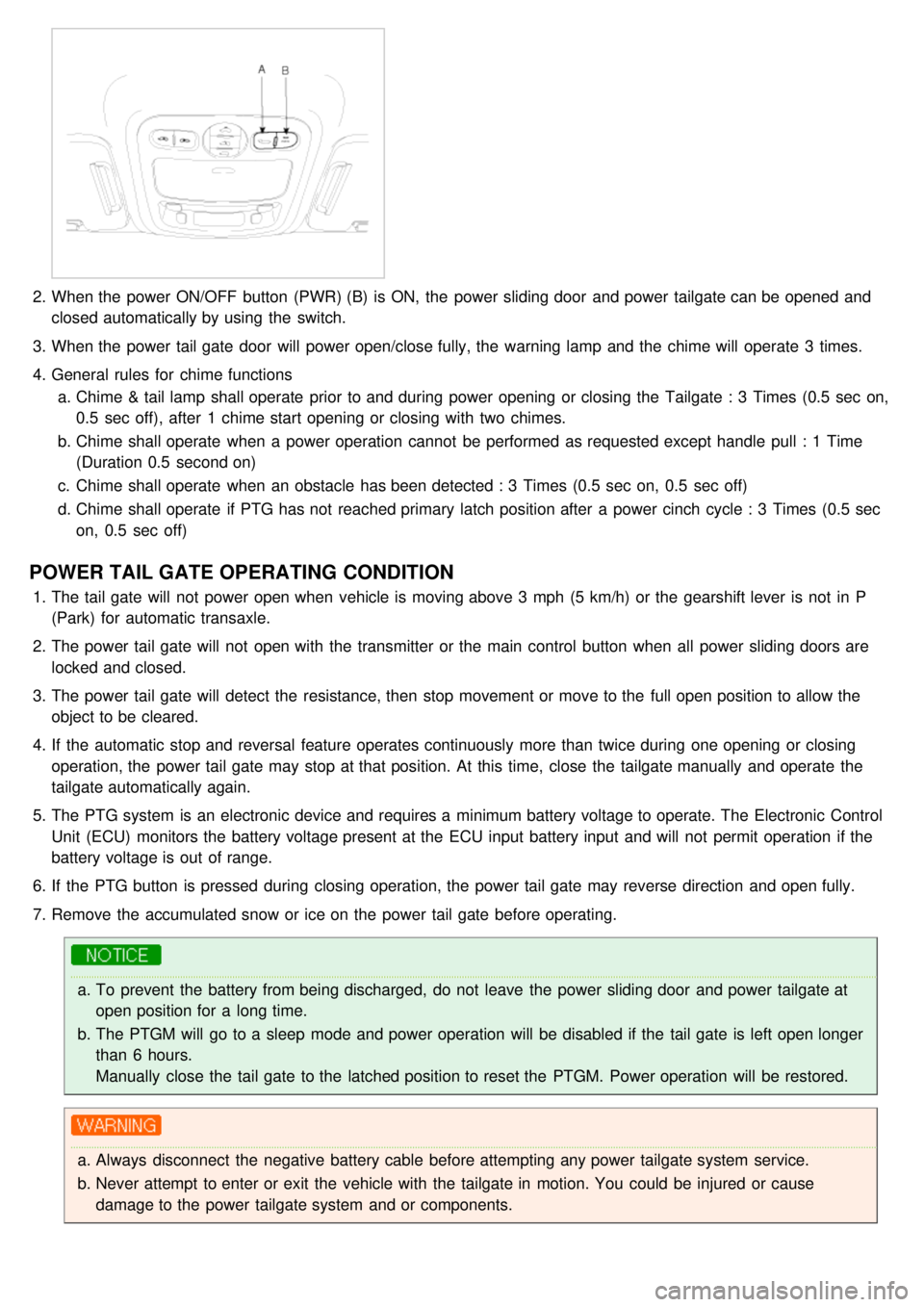
2.When the power ON/OFF button (PWR) (B) is ON, the power sliding door and power tailgate can be opened and
closed automatically by using the switch.
3. When the power tail gate door will power open/close fully, the warning lamp and the chime will operate 3 times.
4. General rules for chime functions
a. Chime & tail lamp shall operate prior to and during power opening or closing the Tailgate : 3 Times (0.5 sec on,
0.5 sec off), after 1 chime start opening or closing with two chimes.
b. Chime shall operate when a power operation cannot be performed as requested except handle pull : 1 Time
(Duration 0.5 second on)
c. Chime shall operate when an obstacle has been detected : 3 Times (0.5 sec on, 0.5 sec off)
d. Chime shall operate if PTG has not reached primary latch position after a power cinch cycle : 3 Times (0.5 sec
on, 0.5 sec off)
POWER TAIL GATE OPERATING CONDITION
1.The tail gate will not power open when vehicle is moving above 3 mph (5 km/h) or the gearshift lever is not in P
(Park) for automatic transaxle.
2. The power tail gate will not open with the transmitter or the main control button when all power sliding doors are
locked and closed.
3. The power tail gate will detect the resistance, then stop movement or move to the full open position to allow the
object to be cleared.
4. If the automatic stop and reversal feature operates continuously more than twice during one opening or closing
operation, the power tail gate may stop at that position. At this time, close the tailgate manually and operate the
tailgate automatically again.
5. The PTG system is an electronic device and requires a minimum battery voltage to operate. The Electronic Control
Unit (ECU) monitors the battery voltage present at the ECU input battery input and will not permit operation if the
battery voltage is out of range.
6. If the PTG button is pressed during closing operation, the power tail gate may reverse direction and open fully.
7. Remove the accumulated snow or ice on the power tail gate before operating.
a.To prevent the battery from being discharged, do not leave the power sliding door and power tailgate at
open position for a long time.
b. The PTGM will go to a sleep mode and power operation will be disabled if the tail gate is left open longer
than 6 hours.
Manually close the tail gate to the latched position to reset the PTGM. Power operation will be restored.
a.Always disconnect the negative battery cable before attempting any power tailgate system service.
b. Never attempt to enter or exit the vehicle with the tailgate in motion. You could be injured or cause
damage to the power tailgate system and or components.
Page 1372 of 1575
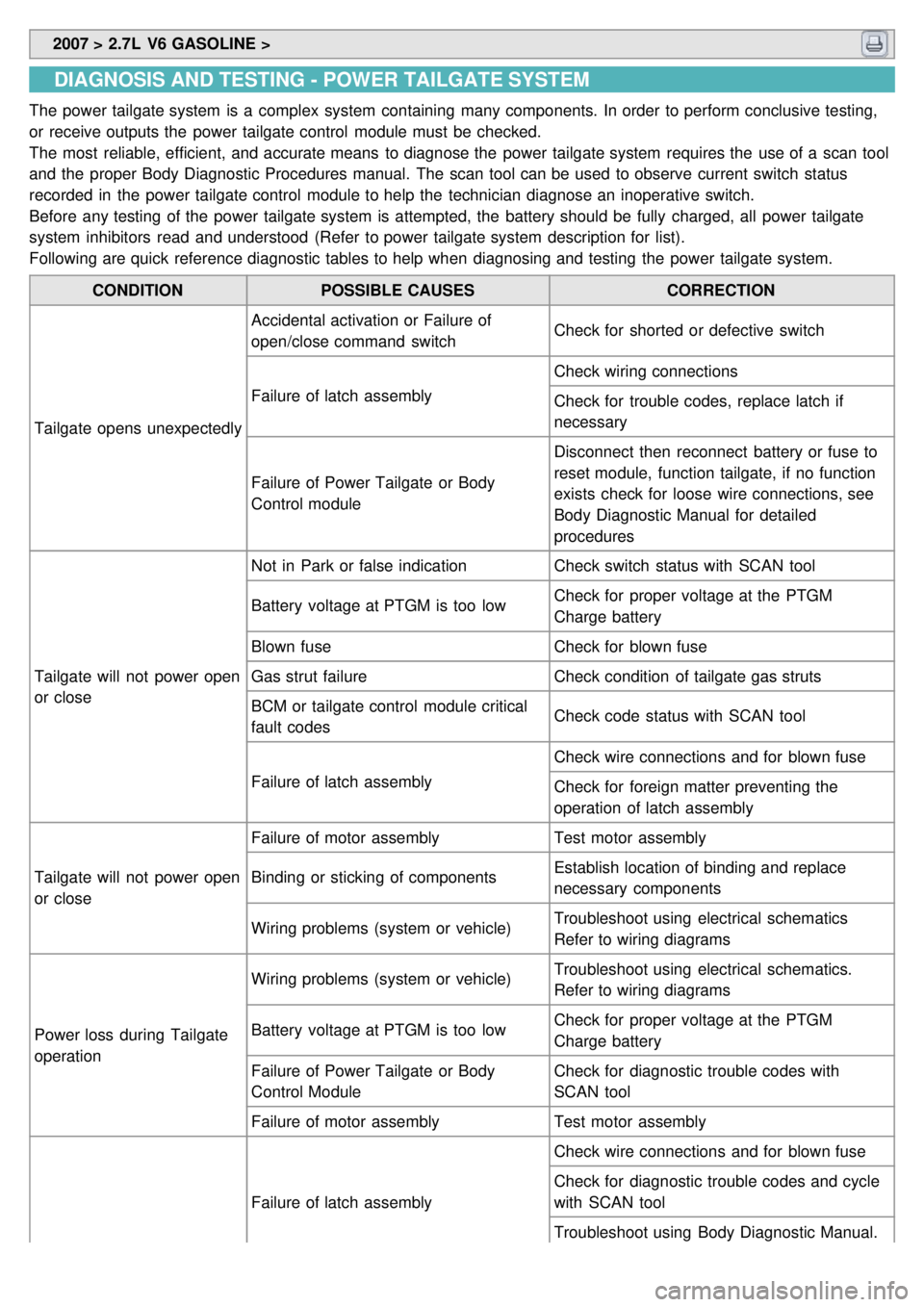
2007 > 2.7L V6 GASOLINE >
DIAGNOSIS AND TESTING - POWER TAILGATE SYSTEM
The power tailgate system is a complex system containing many components. In order to perform conclusive testing,
or receive outputs the power tailgate control module must be checked.
The most reliable, efficient, and accurate means to diagnose the power tailgate system requires the use of a scan tool
and the proper Body Diagnostic Procedures manual. The scan tool can be used to observe current switch status
recorded in the power tailgate control module to help the technician diagnose an inoperative switch.
Before any testing of the power tailgate system is attempted, the battery should be fully charged, all power tailgate
system inhibitors read and understood (Refer to power tailgate system description for list).
Following are quick reference diagnostic tables to help when diagnosing and testing the power tailgate system.
CONDITION POSSIBLE CAUSES CORRECTION
Tailgate opens unexpectedly Accidental activation or Failure of
open/close command switch
Check for shorted or defective switch
Failure of latch assembly Check wiring connections
Check for trouble codes, replace latch if
necessary
Failure of Power Tailgate or Body
Control module Disconnect then reconnect battery or fuse to
reset module, function tailgate, if no function
exists check for loose wire connections, see
Body Diagnostic Manual for detailed
procedures
Tailgate will not power open
or close Not in Park or false indication
Check switch status with SCAN tool
Battery voltage at PTGM is too low Check for proper voltage at the PTGM
Charge battery
Blown fuse Check for blown fuse
Gas strut failure Check condition of tailgate gas struts
BCM or tailgate control module critical
fault codes Check code status with SCAN tool
Failure of latch assembly Check wire connections and for blown fuse
Check for foreign matter preventing the
operation of latch assembly
Tailgate will not power open
or close Failure of motor assembly
Test motor assembly
Binding or sticking of components Establish location of binding and replace
necessary components
Wiring problems (system or vehicle) Troubleshoot using electrical schematics
Refer to wiring diagrams
Power loss during Tailgate
operation Wiring problems (system or vehicle)
Troubleshoot using electrical schematics.
Refer to wiring diagrams
Battery voltage at PTGM is too low Check for proper voltage at the PTGM
Charge battery
Failure of Power Tailgate or Body
Control Module Check for diagnostic trouble codes with
SCAN tool
Failure of motor assembly Test motor assembly
Failure of latch assembly Check wire connections and for blown fuse
Check for diagnostic trouble codes and cycle
with SCAN tool
Troubleshoot using Body Diagnostic Manual.
Replace latch assembly, if necessary
Page 1377 of 1575
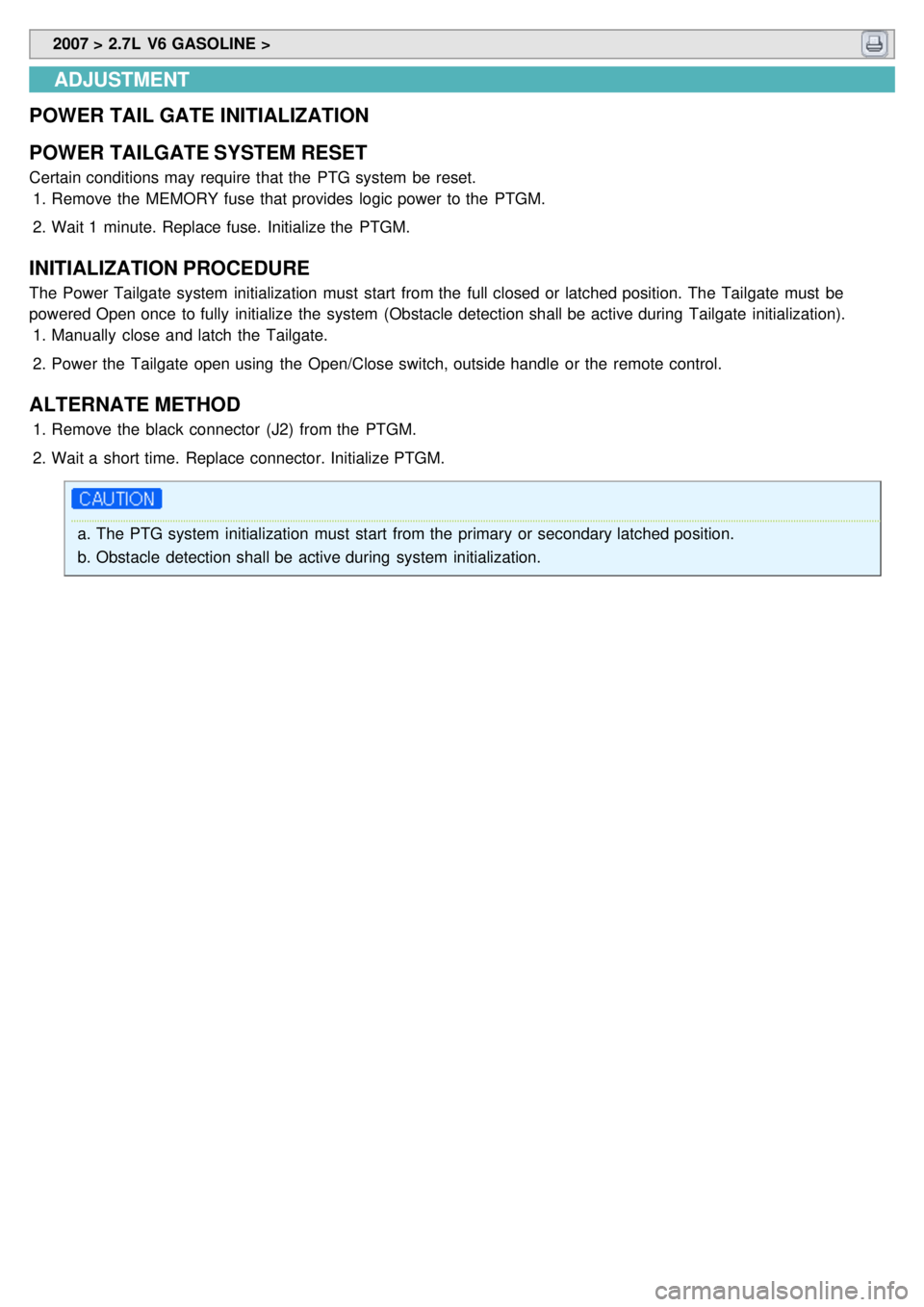
2007 > 2.7L V6 GASOLINE >
ADJUSTMENT
POWER TAIL GATE INITIALIZATION
POWER TAILGATE SYSTEM RESET
Certain conditions may require that the PTG system be reset. 1. Remove the MEMORY fuse that provides logic power to the PTGM.
2. Wait 1 minute. Replace fuse. Initialize the PTGM.
INITIALIZATION PROCEDURE
The Power Tailgate system initialization must start from the full closed or latched position. The Tailgate must be
powered Open once to fully initialize the system (Obstacle detection shall be active during Tailgate initialization).
1. Manually close and latch the Tailgate.
2. Power the Tailgate open using the Open/Close switch, outside handle or the remote control.
ALTERNATE METHOD
1.Remove the black connector (J2) from the PTGM.
2. Wait a short time. Replace connector. Initialize PTGM.
a.The PTG system initialization must start from the primary or secondary latched position.
b. Obstacle detection shall be active during system initialization.